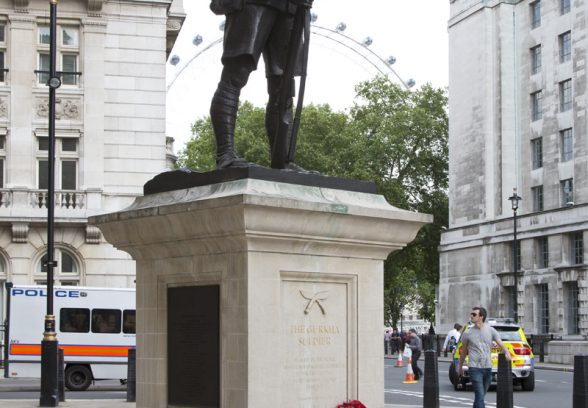This website uses cookies
This website uses cookies to enable it to function properly and to analyse how the website is used. Please click 'Close' to accept and continue using the website.



London: Gurkha Memorial
Architect: Philip Jackson, 1997
Location: Horse Guards Avenue, London
The GurkhaS is the collective name for the Brigade of Nepalese soldiers that serve in the British Army. The Nepalese warriors were known for their tenacious spirit and originally drawn up to serve the British East India Company in the early nineteenth century, forming their own unit after proving their loyalty in the Indian Mutiny. After this they, the 2nd unit, were awarded the honour of wearing the Royal ‘Green jackets’ with distinctive red trimmings. Gurkha Regiments served the British Indian Army in both World Wars losing a total of 43,000 men: their motto became ‘Better to die than be a coward’. They went on to serve in Brunei, The Chinese Cultural Revolution, and the Turkish invasion of Cyprus. They formed part of the Queen’s home guard from 1971. More recently Gurkhas have fought alongside British troops in the Falklands, Gulf War, Kosovo, Sierra Leone, Afghanistan (where they recently protected Prince Harry) and Iraq, as well as undertaking peacekeeping missions for the UN and NATO. They still carry into battle their traditional weapon – an 18-inch long curved knife known as the kukri. In times past, it was said that once a kukri was drawn in battle, it had to “taste blood” – if not, its owner had to cut himself before returning it to its sheath.
The British memorial was unveiled by Queen Elizabeth II in 1997. The quote is taken from Sir Ralph Turner, a former officer in the 3rd Gurkha rifles. ‘ Bravest of the brave, most generous of the generous, never had country more faithful friends than you.’
Hundreds of Nepalese Gurkha soldiers who fought for Britain protested on 19 March 2008 outside the House of Parliament in London, demanding higher pensions and the right to stay in the country they served. This sparked a national petition to entitle them to British Citizenship when their service ends. In September 2008 former Gurkhas won the legal right to retire in the United Kingdom.
Philip Jackson was born in Scotland and trained as a press photographer before joining a design company, where he learnt sculpture. His works are ‘impressionistic’ and often appear on textured bases or against rough backgrounds, the figures becoming finer towards the principal features, faces and hands, as if focusing a lens. His other works include a figure of Mozart in Chelsea, and royals George VI (in Dartmouth Naval College), Queen Elizabeth (Windsor Great Park) and the Queen Mother (The Mall). His figure of ‘The Yomper’ in Portsmouth, a Falklands soldier, has a stocky build and stance that ears comparison with Jagger’s soldiers of the Royal Artillery Memorial. When not working on public commissions, Jackson’s personal worked is mainly themed on masked, particularly Venetian-inspired, figures with and air of mystery.
Jon Wright
Either enter the name of a place or memorial or choose from the drop down list. The list groups memorials in London and then by country

Become a C20 member today and help save our modern design heritage.